This post may contain affiliate links. As an Amazon Associate I earn from qualifying purchases at no extra cost to you.
This super creamy Korean Inspired Gochujang pasta is spicy, savoury, saucy and absolutely irresistible. It is super easy to make, highly comforting in taste and comes together in less than 15 minutes! It is filled with flavours of shallots, garlic and a luscious sauce made with Gochujang and a few simple ingredients.
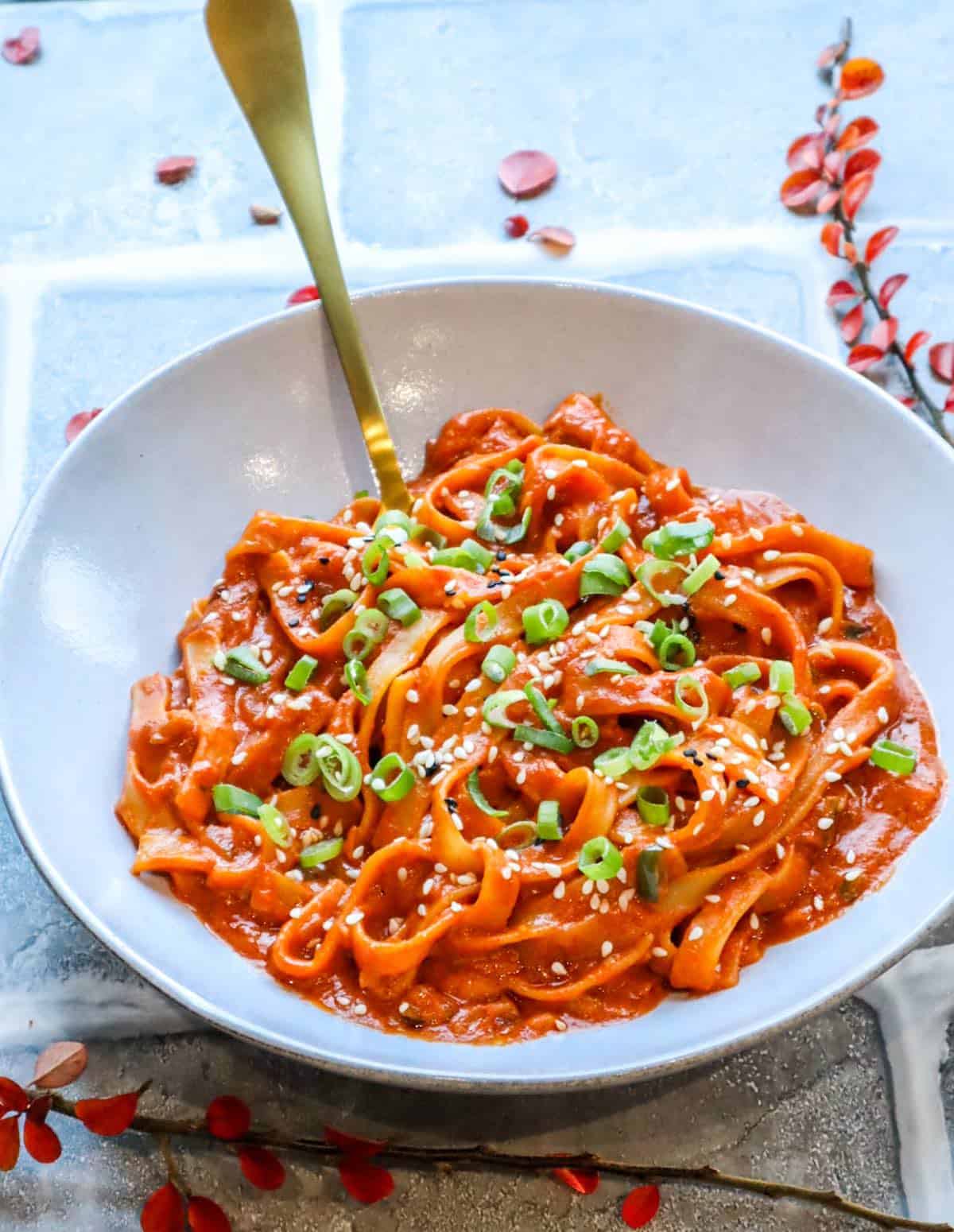
Jump to:
What is gochujang pasta?
My Gochujang pasta is a hearty pasta dish made with a spicy homemade Gochujang sauce and cooked with caramelised shallots, garlic and green chillies. It is spicy, creamy, slightly sweet, nutty, and perfect as a quick weeknight meal.
Recipe inspiration
There are days when I have serious bowl of spicy comfort food to sort me out. And what better way to achieve this than to marry the comforting flavours of the West and the East?
I love the flavour of Gochujang in various Korean dishes and have always wanted to make a bold and spicy pasta sauce with this hero ingredient. I wanted a thick, luscious, almost buttery sauce with a spicy kick.
With added hints of garlic, shallots, chilli, soy sauce and tahini, I created a creamy Gochujang pasta sauce which is SERIOUSLY good.
This spicy, creamy Gochujang pasta recipe is without cream. Yet, it is silky smooth and rich. It is similar to penne alla vodka but a notch above in terms of flavour in my opinion.
Why you should make it
- This delicious Gochujang pasta requires simple ingredients and minimal effort.
- No cream: There are many recipes for Gochujang pasta that use heavy cream to achieve the desired consistency, which tastes good, but it can be heavy to digest and can leave you with an uncomfortable tummy.
- In this recipe, I teach you how to make the best Gochujang pasta without cream. That’s right! Instead of cream, I use tahini for the creamy texture and a nutty flavour which pairs perfectly with rest of the Gochujang pasta sauce ingredients.
- Very little prep: This recipe requires very little preparation. All you need to do is just dice a shallot, a few cloves of garlic and a green chilli.
- Ready in less than 15 minutes: That’s right! This Gochujang pasta comes together in less than 15 minutes.
What is Gochujang
Gochujang is a hot pepper paste used in Korean cooking, made from Gochugaru (red chilli peppers), fermented soya beans, rice, and salt. Due to its delicious umami flavour, it is used in a lot of Korean dishes such as bibimbap, meat dishes, stews, soups, sauces, stir fry recipes etc.
Gochujang adds a delicious, spicy and sweet flavour to dishes. You can make a complex sauce by pairing it with soy sauce, vinegar, maple syrup or honey.
You can make Gochujang at home.
I used store-bought Gochujang paste for this recipe. If you are interested in making your own Gochujang, you can find a detailed Gochujang paste recipe from Maangchi here.
Ingredients to make creamy gochujang pasta
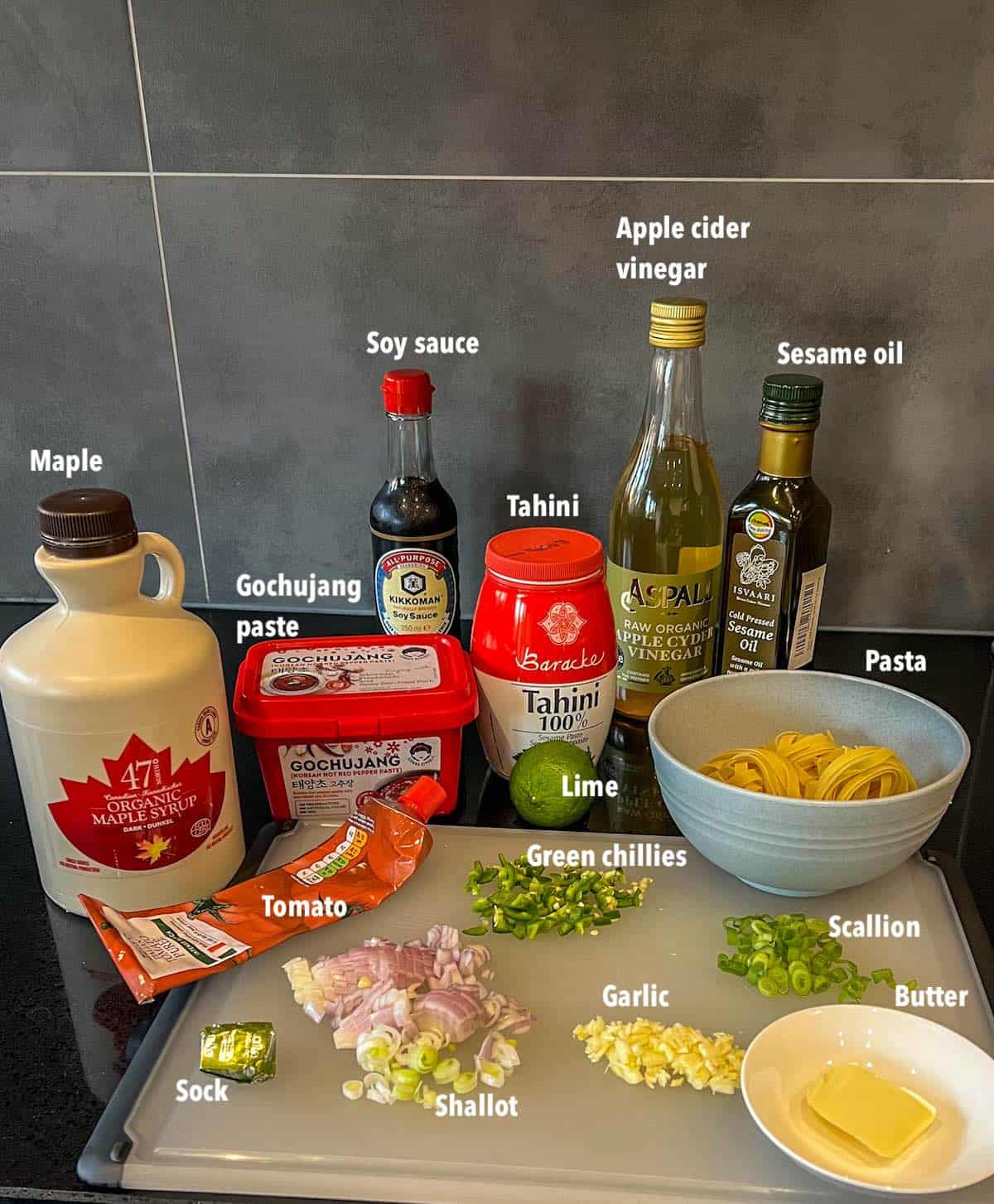
Pasta – I used Tagliatelle in this recipe. You could use rigatoni, penne, spaghetti, fettuccine or even gluten-free pasta. You could also use ramen noodles to make creamy Gochujang noodles.
The hero of this dish is its sauce. Some pasta can hold sauce better than others. Adjust the amount of pasta water and sauce for the right consistency.
Sesame oil – Sesame oil adds a slightly nutty taste which works brilliantly in Asian cuisine. It pairs very well with tahini, gochujang and other asian ingredients in this recipe. You can substitute sesame oil with another neutral oil, such as sunflower or canola oil.
Butter – Butter adds richness and a depth of flavour to the sauce. Adding butter is optional. For a dairy-free alternative, skip butter or substitute with vegan butter.
Shallots, garlic and green chillies – These cannot be skipped. They are a must in creating the base of the sauce. The combination of these three ingredients and the order in which they are cooked is vital to develop the right flavour for this sauce.
Shallots add a delicate, sweet and sharp flavour. Use white or red onion in case you cannot find shallots.
I used medium hot green chilli for this recipe. Adjust the quantity of chilli according to the type of chilli and your spice tolerance.
Vegetable stock cube – Vegetable stock adds a lot of flavour to the sauce. If you cannot find it, just use boiling water. Adding stock cube is optional.
Korean Gochujang paste – This is the hero ingredient in this recipe. I used Ajumma Republic Gochujang Chilli Paste which I purchased from Amazon. I highly recommend using this paste for its rich umami flavour. In case you cannot find Gochujang paste, see the section below for substitutions that work with this recipe.
Tomato paste – Adds a deep tomato flavour with a hint of sweetness and acidity. It adds a dark red colour to the sauce and pairs wonderfully with the rest of the ingredients.
Soy sauce – Adds a salty umami flavour which works brilliantly with Gochujang and brings the sauce to life. Because soy sauce is salty, this pasta sauce doesn’t require additional salt.
Tahini – Tahini makes the sauce creamy and adds a lovely nutty sesame flavour. Without tahini the sauce would be runny. Hence do not skip this. Other spicy pasta recipes typically use heavy cream to achieve the desired creamy texture but having tried it, I can attest that it is hard to digest and leaves you uncomfortable. Tahini, on the other hand, is much easier to digest and is dairy-free. I love using Baracke tahini as it contains 100%sesame paste.
If you cannot find tahini, you can use cashew cream.
If you are keen on using heavy cream, add it to the pan just after pouring the sauce on a low flame. See detailed instructions in the recipe card.
Apple cider vinegar – Adds the right level of acidity to the sauce and helps balance other flavours.
Maple syrup – Helps balance the acidity and neutralise the other flavours in the sauce. You can substitute maple syrup with an equal quantity of honey or powdered sugar. I love using 47 North Canadian Organic Maple Syrup for its rich robust taste.
Lime juice – Adds freshness and citrus flavour to the sauce.
Sesame oil – Adds a nutty and toasty flavour to the sauce and brings everything together.
Spring onion and toasted sesame seeds – To jazz up the pasta, I highly recommend garnishing with sliced scallions (also known as green onion or spring onion) and a sprinkle of toasted black and/or white sesame seeds. It is these little details that make a great difference in taste.
How to make it
Before you start to cook, dice the shallots, garlic, green chilli and scallions and have them ready.
It is super easy to make this Gochujang pasta. It requires 3 simple steps:
Make the creamy Gochujang pasta sauce
Crush the stock cube in a small jar and pour boiling water. Add the rest of the sauce ingredients and whisk until thick and creamy. Make sure there are no lumps.
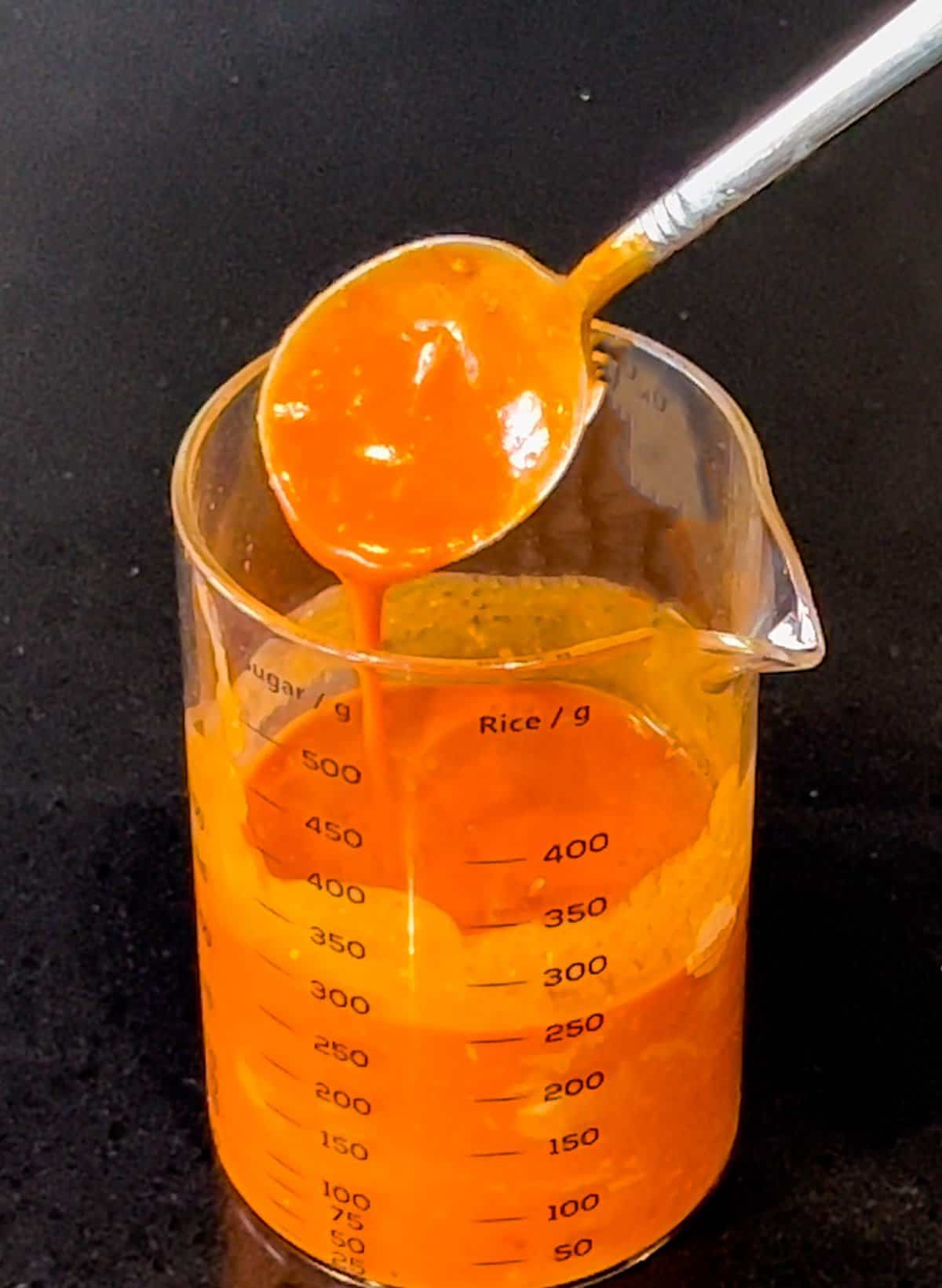
Cook the pasta
Cook the pasta in a pot of boiling water according to the package instructions. Do not rinse under cold water, as it can lose the starch and prevent the pasta from absorbing the sauce.
Bring the spicy Gochujang sauce and pasta together
While the pasta is cooking, heat oil in a large pan. Add butter and let it melt. Add shallots and saute for about 3 to 4 minutes. Then, add the garlic and green chillies and saute until fragrant.
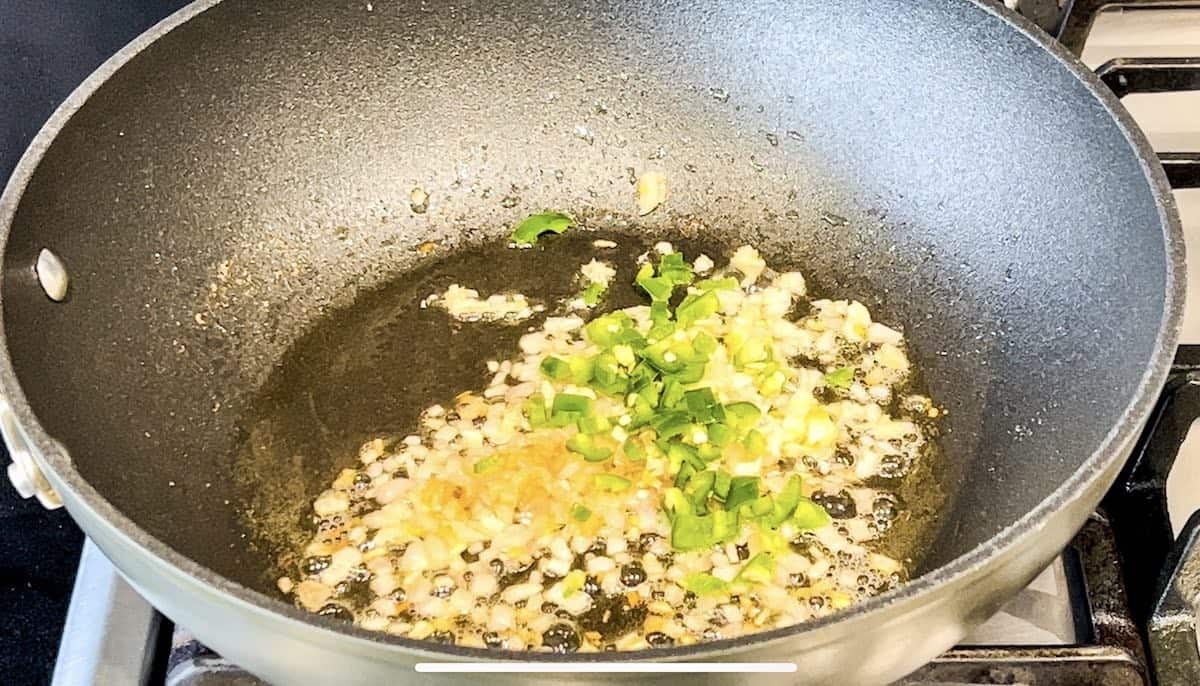
Pour the sauce and cook for a minute.
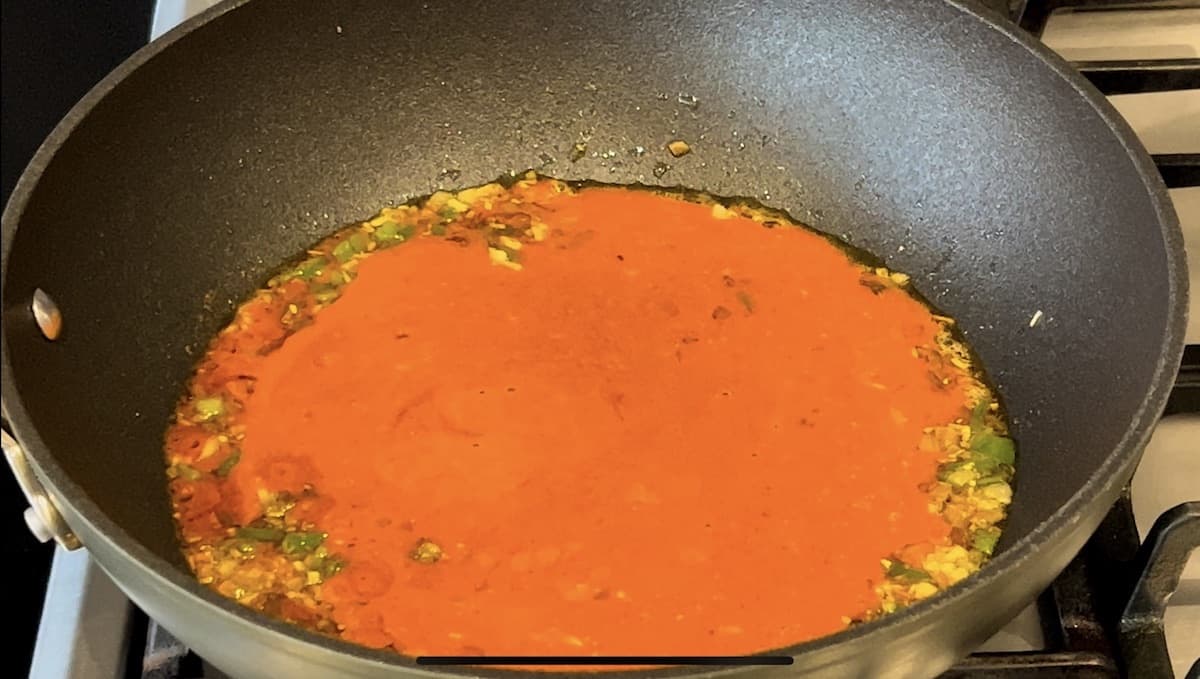
Add the pasta and reserved pasta water and toss to combine. The pasta should be saucy and buttery. Add a dollop of butter (completely optional) to make it more glossy and tasty. Serve as is or garnish with spring onion and toasted sesame seeds.
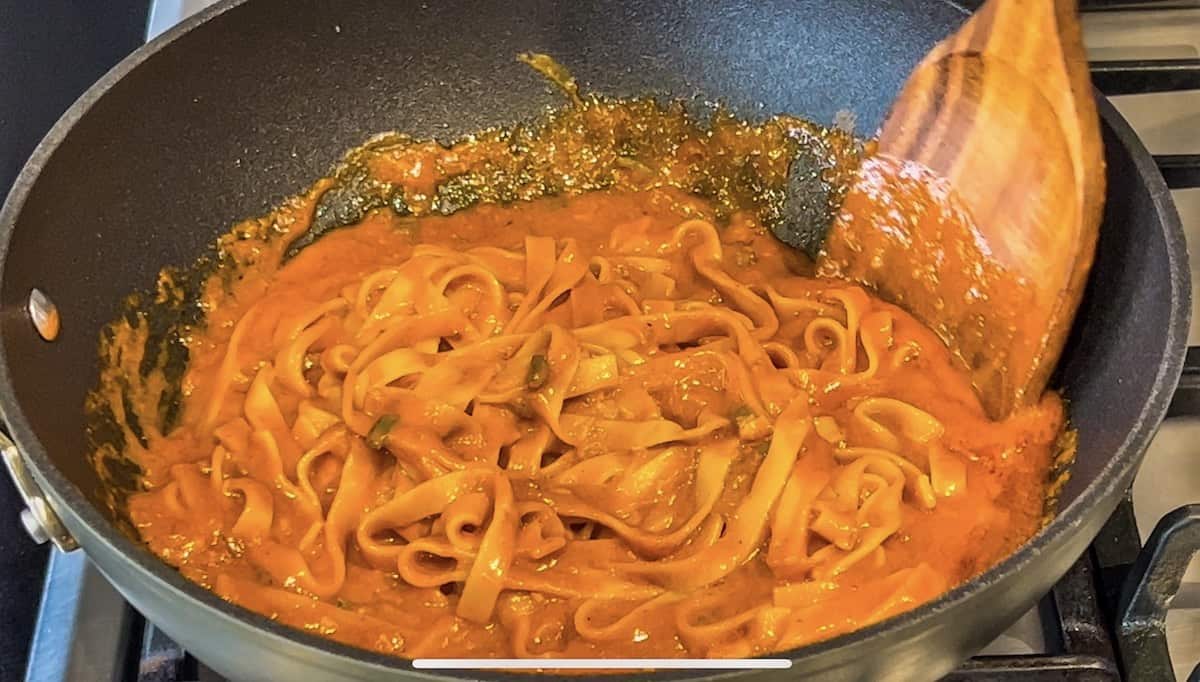
You can use this creamy Gochujang pasta recipe also to make Gochujang noodles or Gochujang spaghetti.
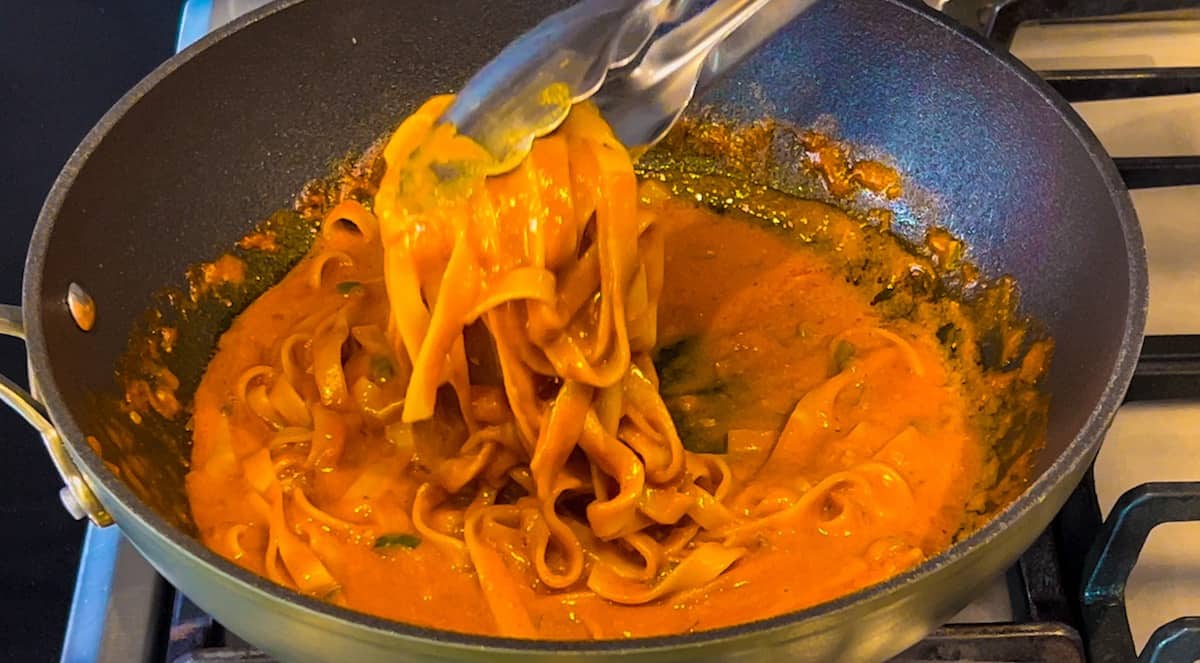
Note – It is best to cook the sauce while the pasta is cooking. Doing this saves time and prevents the pasta from drying out.
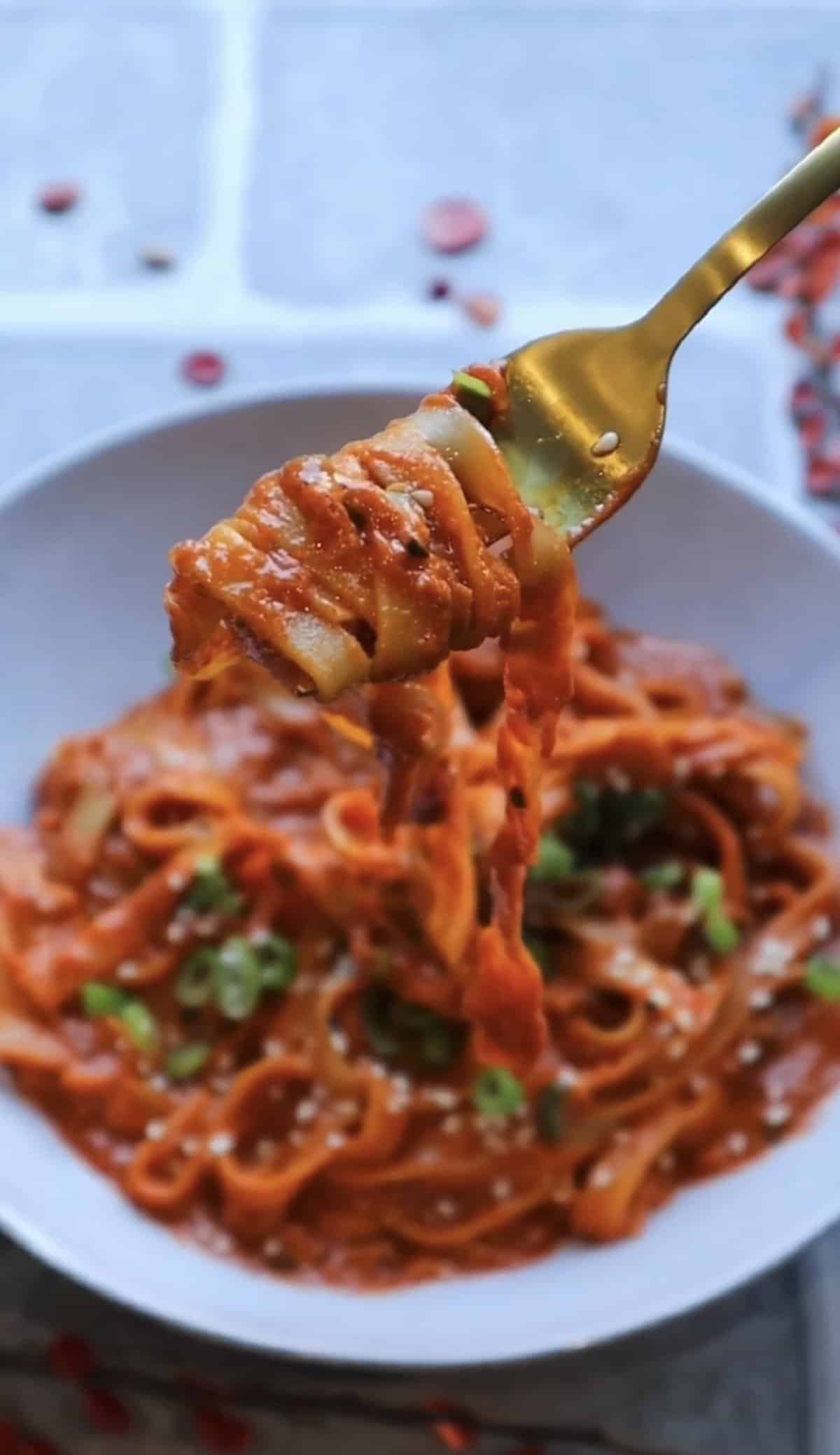
Serving instructions
Serve this saucy Gochujang pasta when it is hot. Drizzle some chilli oil, thinly sliced scallions, and toasted sesame seeds to take it to the next level.
For a cheesy umami-packed flavour, add some grated parmesan cheese or drizzle some nutritional yeast (for a dairy-free option).
To make it a wholesome meal, serve it with a few slices of cucumber or fresh green salad.
Storage and reheat instructions
Gochujang pasta makes for a delicious lunch the next day!
Store leftovers in an airtight container in the fridge for up to 3 days.
When ready to eat, reheat the pasta on the stovetop. To prevent the pasta from drying, add 2 to 3 tablespoons of water in small increments while reheating.
This pasta is also freezer friendly. You can freeze this up to 3 months in an airtight container. Make sure to defrost by thawing the pasta in the fridge or overnight at room temperature. Then, follow the instructions above to reheat and enjoy.
Variations
Add sauteed mushrooms to make mushroom gochujang pasta.
Sauteed broccoli or roasted bell peppers also go well with this pasta. I love adding vegetables to make it a wholesome dish.
You can also add some stir-fried tofu for additional protein.
FAQ
Yes, you can. You can find a detailed recipe from Maangchi here. Her website has a huge collection of some of the best Korean recipes.
Firstly, they are not the same. Gochujang sauce uses Gochujang paste as the base ingredient and is further diluted with soy sauce, vinegar, sweetener and a few other ingredients to a thin consistency. I am using Gochujang paste in this recipe.
Yes, you can. But the sauce will not be a like-to-like substitute for the Gochujang paste. Just use the same amount of Gochujang sauce as the Gochujang paste, but do not add the soy sauce, apple cider vinegar, maple syrup and lime juice.
Use any pasta of your choice. Penne and rigatoni tend to hold more sauce relatively. Gluten-free pasta works great too.
Instead of pasta, you could also use ramen noodles to make Gochujang noodles.
Gochujang paste has a unique umami flavour which is hard to substitute. But below are a few replacements you could consider in this Gochujang pasta recipe:
Use a mixture of miso paste and Gochugaru (Korean chilli flakes) instead of Gochujang paste. If you do not have Gochugaru, use regular red chilli powder.
Use Gochujang sauce instead of Gochujang paste, soy sauce, vinegar, lime juice and maple syrup.
Ssamjang(a thick, spicy Korean paste with Gochujang as a key ingredient) is a close store-bought substitute. A mixture of Ssamjang with maple syrup and chilli powder or red pepper flakes works excellent as a replacement for Gochujang paste in this recipe.
Sriracha sauce is a close flavour match for gochujang paste due to its sweet and spicy fermented flavour. But due to its thin texture, it works better as a replacement for Gochujang paste if mixed with miso paste.
Taste and adjust the flavours while making your own pasta sauce. Here is an excellent resource if you are interested in reading about more substitutes for Gochujang.
More spicy recipes to love
Vegan Gigi Hadid pasta recipe without vodka
If you try this recipe, please let me know in the comments and don’t forget to leave a rating. I love hearing from you!
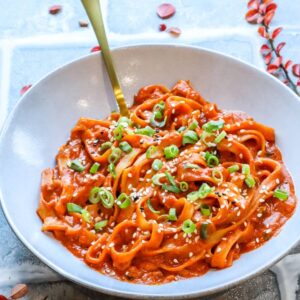
Spicy creamy Gochujang pasta in 15 minutes|No cream
Ingredients
To cook pasta:
- 150 g pasta of your choice I used Tagliatelle
- 1.5 l water
Saute:
- 2 tablespoon sesame oil
- 1 tablespoon unsalted butter for a dairy-free alternative, skip butter or sub with vegan butter
- 1 shallot diced
- 3 cloves garlic minced
- 1 green chilli finely chopped
Sauce:
- ½ cube vegetable stock
- 100 ml boiling water
- 2 tablespoon Gochujang paste
- ¾ tablespoon tomato paste
- 2 tablespoon soy sauce
- 4 tablespoon tahini
- 1 tablespoon apple cider vinegar
- 1 tablespoon maple syrup
- half a lime juice
- 1 tablespoon sesame oil
To garnish:
- 1 stalk spring onion thinly sliced
- 1 tablespoon white sesame seeds
- 1 tablespoon black sesame seeds
Instructions
- Add the stock cube to a medium mixing bowl or a glass jar and pour boiling water over it. Crush the stock cube till it dissolves completely.
- Add the Gochujang paste, tomato paste, soy sauce, tahini, apple cider vinegar, maple syrup, lime juice and sesame oil and stir until creamy and free of lumps.
- Bring water to a boil in a large pot and cook the pasta according to the package instructions. Reserve ¼ cup (60 ml) of pasta water before draining the pasta.
- While the pasta is cooking, heat oil in a large pan over medium heat. Once the oil is hot, add butter and let it melt.
- Add shallots and saute for 3-4 minutes, stirring frequently. Then add the garlic and green chillies and saute for a minute.
- Pour the sauce and cook for a minute. If you use heavy cream instead of tahini, add it to the pan at this stage on a low flame and mix until thoroughly combined.
- Add the cooked pasta and reserved pasta water and toss to combine.
- Garnish with spring onion, white sesame seeds and black sesame seeds and enjoy!
Notes
- Nutrition values are a rough estimate for guidance.
- The level of spice in Gochujang can vary depending on the brand. Be sure to taste the Gochuang before you prepare the sauce and adjust according to the level of spice you prefer.


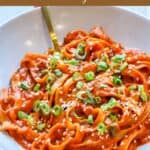
Leave a Reply